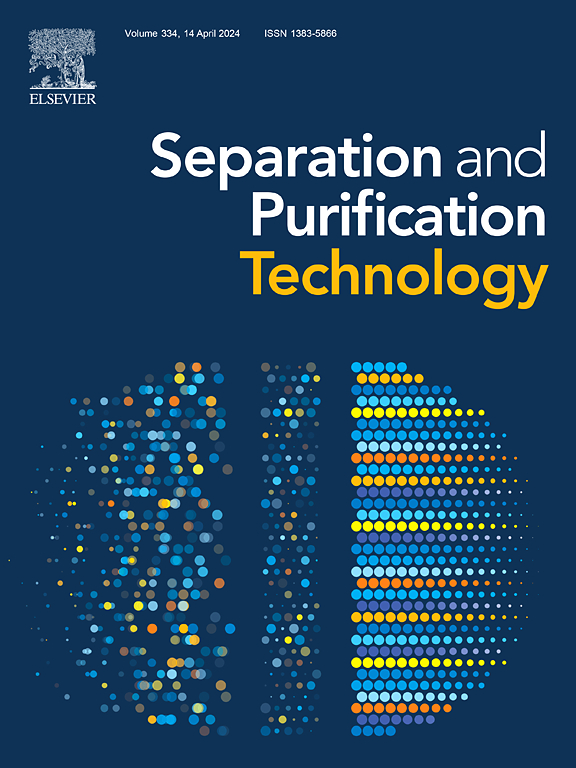微/纳米气泡辅助浮选技术去除水中微/纳米塑料研究进展
IF 8.1
1区 工程技术
Q1 ENGINEERING, CHEMICAL
引用次数: 0
摘要
微/纳米塑料(MNPs)因其对水生环境的危害而引起全球关注。为利用创新技术从环境中清除MNPs做出了重大努力。本文探讨了基于微/纳米气泡(MNBs)的浮选方法的研究进展。讨论了MNPs的来源、分布途径、环境和健康影响。传统去除MNPs技术的局限性引起了人们对MNBs等先进方法的关注。mnb是微小的充满气体的腔体,尺寸从微米到纳米不等。它们独特的特性,如高表面积体积比、高zeta电位和在水中的长时间稳定性,增强了它们在净化过程中的应用。因此,本文综述了这些MNBs的基本特性、生成技术和在不同水生环境中的应用。通过解决浮选机制、影响因素(例如,MNPs/MNBs性质、操作参数)和工艺优化,重点关注MNBs在增强基于浮选的MNPs去除中的作用。最后,本工作旨在评估当前可扩展性的局限性,并评估在现实场景中实施mnp辅助浮选修复的未来方向。它还强调了最近在塑料废物管理方面的举措,重点是建立旨在减轻塑料污染的监管框架和政策,从而指导研究人员制定创新和有效的漂浮战略,以更好地管理和减轻水生环境中的MNPs污染。本文章由计算机程序翻译,如有差异,请以英文原文为准。


Micro/nanoplastics removal from the aquatic environment using micro/nanobubbles-assisted flotation technology: A review
Micro/nanoplastics (MNPs) spark global concerns due to their dangers to the aquatic environment. Significant efforts are made to remove MNPs from the environment using innovative technologies. This work explores the progress of the flotation methods based on Micro/Nanobubbles (MNBs) for the MNPs elimination. The sources, distribution pathways, environmental, and health impacts of MNPs are discussed. The limitations of conventional technologies in MNPs removal draw attention to the advanced approaches like MNBs. MNBs are tiny gas-filled cavities with sizes ranging from micrometers to nanometers. Their unique characteristics, such as high surface area-to-volume ratios, elevated zeta potentials, and prolonged stability in water, enhance their application in purification processes. Therefore, the fundamental properties, generation techniques, and applications of these MNBs across diverse aquatic settings are reviewed. It is focused on the role of MNBs in enhancing the flotation-based removal of MNPs by addressing the flotation mechanisms, influencing factors (e.g., MNPs/MNBs properties, operational parameters), and process optimization. Finally, this work aims to evaluate the current limitations of scalability and assess future directions for implementing MNB-assisted flotation of MNPs remediation in real-world scenarios. It also highlights recent initiatives in plastic waste management focused on establishing regulatory frameworks and policies aimed at mitigating plastic pollution, thereby guiding researchers toward the development of innovative and effective flotation strategies for better management and mitigation of MNPs pollution in aquatic environments.
求助全文
通过发布文献求助,成功后即可免费获取论文全文。
去求助
来源期刊

Separation and Purification Technology
工程技术-工程:化工
CiteScore
14.00
自引率
12.80%
发文量
2347
审稿时长
43 days
期刊介绍:
Separation and Purification Technology is a premier journal committed to sharing innovative methods for separation and purification in chemical and environmental engineering, encompassing both homogeneous solutions and heterogeneous mixtures. Our scope includes the separation and/or purification of liquids, vapors, and gases, as well as carbon capture and separation techniques. However, it's important to note that methods solely intended for analytical purposes are not within the scope of the journal. Additionally, disciplines such as soil science, polymer science, and metallurgy fall outside the purview of Separation and Purification Technology. Join us in advancing the field of separation and purification methods for sustainable solutions in chemical and environmental engineering.
 求助内容:
求助内容: 应助结果提醒方式:
应助结果提醒方式:


